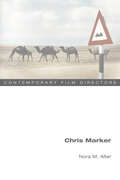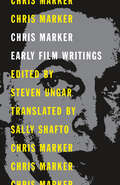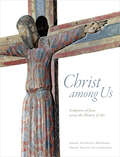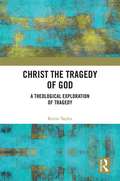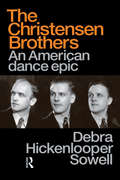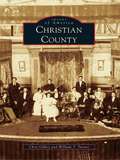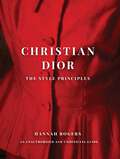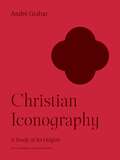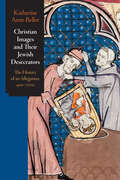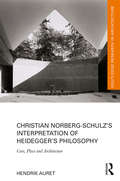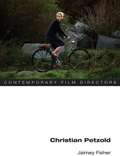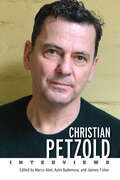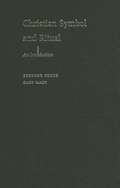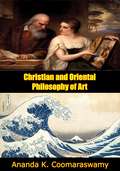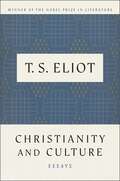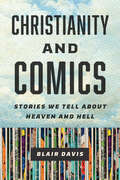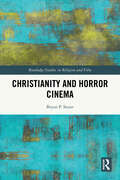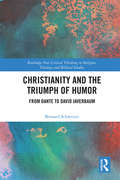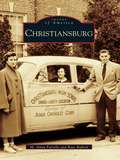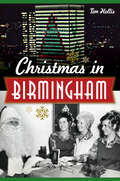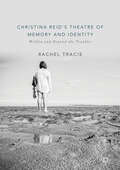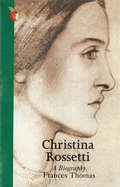- Table View
- List View
Chris Marker (Contemporary Film Directors)
by Nora M. AlterThe maverick filmmaker's personal and political relationships with film Best known in the United States for his visionary short film La Jetée, Chris Marker spearheaded the bourgeoning Nouvelle Vague scene in the late 1950s. His distinctive style and use of still images place him among the postwar era's most influential European filmmakers. His fearless political cinema, meanwhile, provided a bold model for other activist filmmakers. Nora M. Alter investigates the core themes and motivations behind an unpredictable and transnational career that defies easy classification. A photographer, multimedia artist, writer, broadcaster, producer, and organizer, Marker cultivated an artistic dynamism and always-changing identity. ""I am an essayist,"" Marker once said, and his 1953 debut filmic essay The Statues Also Die (with Alain Resnais) exposed the European art market's complicity in atrocities in the former Belgian Congo. Ranging geographically as well as artistically, Marker's travels led to films like the classic Sans Soleil and Sunday in Peking. His decades-long struggle against global injustice involved him with Night and Fog, Le Joli Mai, Far from Vietnam, Le fond du l'air est Rouge, and Prime Time in the Camps. Insightful and revealing, Chris Marker includes interviews with the notoriously private director.
Chris Marker: Early Film Writings
by Chris MarkerFormative writings by French avant-garde filmmaker Chris Marker It is hard to imagine French cinema without La Jetée (1962), the time-travel short feature by the reclusive French filmmaker Christian François Bouche-Villeneuve, better known as Chris Marker. He not only influenced artists ranging from David Bowie to J. G. Ballard but also inspired the cult film 12 Monkeys. Marker&’s influence expanded beyond his own films through his writings for the French monthly Esprit as well as anthologies and newly founded film publications. This first English translation of Marker&’s early writings on film brings together reviews and essays, published between 1948 and 1955, that span the topics of film style, adaptation, and ideology, as well as animation and the debates surrounding 3-D and wide-screen technologies, ranging from late silent-era films to postwar Hollywood&’s efforts to contend with the rise of television. Readers will find commentary on Laurence Olivier&’s 1944 screen adaptation of Henry V, a scathing review of Robert Montgomery&’s Lady in the Lake (1947), critiques of Walt Disney productions, a discussion of the pitfalls of prioritizing commercial success over aesthetic values, and more. An indispensable resource for cinephiles and scholars alike, these texts document the emergence of Marker&’s critical voice and situate him alongside such contemporaries as André Bazin and Eric Rohmer, as well as the future French New Wave figures Jean-Luc Godard and François Truffaut. They show how his remarks on individual films open onto his engagement with films as social and cultural phenomena.
Christ among Us: Sculpted Images of Jesus from across the History of Art
by Joseph Antenucci Becherer Henry Martin LuttikhuizenNo single figure has been more often featured in Western art than Jesus Christ. Sculptures, particularly—though they have received less notice than paintings—provide some of the most moving representations in their capacity to show Christ alongside us in three-dimensional space.In this &“catalog for an imagined exhibition,&” two prominent art historians—one from the Roman Catholic tradition, one from the Protestant tradition—offer a guided tour of fifty-two sculptures of Jesus Christ from throughout the Western world. The chronological scope of the selection ranges from the third century to the present, with the work of well-known sculptors featured alongside the work of less familiar artists who deserve more attention.Along with lush, high-resolution photographs, each piece is accompanied by an essay that places it in context and brings it to life, so readers can experience the sculpture almost as vividly as they would in person. Those interested in devotional as well as artistic significance will find inspiration in the striking representations of Christ in his many forms: healer, sage, sovereign, and savior, from his humble yet majestic birth to his harrowing death and miraculous resurrection.
Christ the Tragedy of God: A Theological Exploration of Tragedy
by Kevin TaylorTragedy is a genre for exploring loss and suffering, and this book traces the vital areas where tragedy has shaped and been a resource for Christian theology. There is a history to the relationship of theology and tragedy; tragic literature has explored areas of theological interest, and is present in the Bible and ongoing theological concerns. Christian theology has a long history of using what is at hand, and the genre of tragedy is no different. What are the merits and challenges of placing the central narrative of the passion, death and resurrection of Christ in tragic terms? This study examines important and shared concerns of theology and tragedy: sacrifice and war, rationality and order, historical contingency, blindness, guilt, and self-awareness. Theologians such as Reinhold Niebuhr, Hans Urs von Balthasar, Martin Luther King Jr., Simone Weil, and Boethius have explored tragedy as a theological resource. The historical relationship of theology and tragedy reveals that neither is monolithic, and both remain diverse and unstable areas of human thought. This fascinating book will be of keen interest to theologians, as well as scholars in the fields of literary studies and tragic theory.
Christensen Brothers: An American Dance Epic (Choreography and Dance Studies Series #Vol. 16)
by Debra Hickenlooper SowellFirst Published in 1998. Routledge is an imprint of Taylor & Francis, an informa company.
Christian Art: A Very Short Introduction
by Beth WilliamsonThis Very Short Introduction decodes the key themes, signs, and symbols found l in Christian art: the Eucharist, the image of the Crucifixion, the Virgin Mary, the Saints, Old and New Testament narrative imagery, and iconography. It also explores the theological and historical background of Christian imagery, from the devotional works of the Medieval and Renaissance periods, to the twenty first century. Williamson uses examples from, among others, Cimabue, Michelangelo, and Rosetti. She concludes by outlining the co-existence in contemporary "post-Christian" culture of the deliberately controversial works of artists such as Andres Serrano and Chris Ofili, alongside the consciously devotional works of those such as Eric Gill and Peter Blake.
Christian County
by William T. Turner Chris GilkeyIn the years since Christian County was founded more than 210 years ago, the rural area--including many small communities and the county seat of Hopkinsville--has become a historic treasure of various architectural styles. Water-powered mills are representative of the first local industry. Blacksmith shops, followed by several small craft shops, preceded the largest 19th-century industry: the manufacturing of Mogul brand farm wagons. A plow factory and a butter manufacturing facility were also two of several short-lived industrial attempts to make a great financial success. Throughout the 20th century, changing social and economic growth brought the demolition of many priceless architectural examples. This title presents a close observation of many of these vanished landmarks, with old churches, public buildings, country stores, schools, and road toll gates providing a glimpse into the county's past.
Christian Dior: The Style Principles
by Hannah Rogers&“This pretty, illustrated volume dives into all sorts of classic style principles inspired by Dior and will look lovely on display.&” —Cosmopolitan Transform your everyday style based on timeless wisdom of iconic designer Christian Dior with this practical guide to romantic elegance.Christian Dior: The Style Principles is an illustrated guide that draws inspiration from the iconic French fashion designer&’s legacy of quality over quantity and emphasizing the importance of individuality. The book offers accessible ideas on how to achieve Dior&’s style with silhouettes, patterns, prints, midi skirts, handbags, and gold jewelry. You&’ll learn how to embrace your waist, channel your inner princess, and discover your color palette. It further explores the world of makeup and perfumes, offering advice on finding your signature scent, maintaining manageable hair, and wearing fresh-looking makeup and polished nails. Ultimately, this book is not just about fashion; it&’s about self-expression and feeling like your best self every single day. It&’s about understanding the impact of a visionary fashion architect and master couturier and serves as a fashion lover&’s dream guide to dress in the style of Dior.
Christian Iconography: A Study of Its Origins (The A. W. Mellon Lectures in the Fine Arts #10)
by André GrabarAn illuminating look at the iconography of the early church and its important place in the history of Christian artIn this book, historian André Grabar demonstrates how early Christian iconography assimilated contemporary imagery of the time. Grabar looks at the most characteristic examples of paleo-Christian iconography, dwelling on their nature, form, and content. He explores the limits of originality in such art, its debt to figurative art, and the broader cultural climate in the Roman Empire, drawing a distinction between expressive images—that is, genuine works of art—and informative ones. Throughout, Grabar establishes the importance of imperial iconography in the development of Christian portraits and sheds light on the role they played alongside other forms of Christian piety in their day.
Christian Images and Their Jewish Desecrators: The History of an Allegation, 400-1700 (Jewish Culture and Contexts)
by Katherine Aron-BellerIn Christian Images and Their Jewish Desecrators, historian Katherine Aron-Beller analyzes the common Christian charge that Jews habitually and compulsively violated Christian images, identifying this allegation as one that functioned alongside other anti-Jewish allegations such as ritual murder, blood libel, and host desecration to ultimately inform dangerous and long-lasting prejudices in medieval and early modern Europe. Through an analysis of folk tales, myths, legal proceedings, and religious art, Aron-Beller finds that narratives alleging that Jews committed violence against images of Christ, Mary, and the disciples flourished in Europe between the fifth and seventeenth centuries. She then explores how these narratives manifested differently across the continent and the centuries, finding that their potency reflected not Jewish actions per se, but Christians’ own concerns about slipping into idolatry when viewing depictions of religious figures. In addition, Aron-Beller considers Jews’ own attitudes toward Christian imagery and the ways in which they responded to and rejected—or embraced—such allegations. By examining how desecration allegations affected Jewish individuals and communities spanning Byzantium, medieval England, France, Germany, and early modern Spain and Italy, Aron-Beller demonstrates that this charge was a powerful expression of the Christian majority’s anxiety around committing idolatry and their eagerness to participate in practices of veneration that revolved around visual images—an anxiety that evolved through the centuries and persists to this day.
Christian Lacroix and the Tale of Sleeping Beauty: A Fashion Fairy Tale Memoir
by Camilla MortonCan dormant beauty really be awakened by a Princely touch?The classic story of Sleeping Beauty has had us believing so for years. Now, spun as if by magic from the threads of the beloved Brothers Grimm fairy tale comes the enchanting memoir of fashion designer Christian Lacroix—the haute couture icon whose creations have invited millions of women to enjoy the fairy princess fashions of their dreams. Sorcery and style combine in this enchanting new twist on a time-honored tale; re-imagined by international bestselling author Camilla Morton, and illustrated by Monsieur Lacroix himself, the spell cast by Christian Lacroix and the Tale of Sleeping Beauty will reawaken every reader’s childhood fantasies—reassuring you that dreams really do come true…
Christian Norberg-Schulz’s Interpretation of Heidegger’s Philosophy: Care, Place and Architecture (Routledge Research in Architecture)
by Hendrik AuretChristian Norberg-Schulz’s Interpretation of Heidegger’s Philosophy investigates the theoretical contribution of the world-renowned Norwegian architectural theorist Christian Norberg-Schulz (1926 – 2000) and considers his architectural interpretation of the writings of German philosopher Martin Heidegger. Though widely recognised as providing the most comprehensive reading of Heideggerian philosophy through the lens of architecture, this book argues that Norberg-Schulz neglected one of the key aspects of the philosopher’s contributions: the temporal nature of being-in-the-world as care. The undeveloped architectural implications of the ontological concept of care in his work prevented the fruition of his ultimate aim, transforming the ‘art of place’ into an ‘art of living’. This book seeks to realign Norberg-Schulz’s understanding of time as continuity and change to present a holistic approach grounded in Heidegger’s phenomenological philosophy; architecture as art of care. Aimed at academics and scholars in architectural theory, history and philosophy, Christian Norberg-Schulz’s Interpretation of Heidegger’s Philosophy surveys the implications and significance of the theorist’s works on architectural criticism in the late 20th century.
Christian Petzold (Contemporary Film Directors)
by Jaimey FisherIn eleven feature films across two decades, Christian Petzold has established himself as the most critically celebrated director in contemporary Germany. The best-known and most influential member of the Berlin School, Petzold's career reflects the trajectory of German film from 1970s New German Cinema to more popular fare in the 1990s and back again to critically engaged and politically committed filmmaking. In the first book-length study on Petzold in English, Jaimey Fisher frames Petzold's cinema at the intersection of international art cinema and sophisticated genre cinema. This approach places his work in the context of global cinema and invites comparisons to the work of directors like Pedro Almodovar and Rainer Werner Fassbinder, who repeatedly deploy and reconfigure genre cinema to their own ends. These generic aspects constitute a cosmopolitan gesture in Petzold's work as he interprets and elaborates on cult genre films and popular genres, including horror, film noir, and melodrama. Fisher explores these popular genres while injecting them with themes like terrorism, globalization, and immigration, central issues for European art cinema. The volume also includes an extended original interview with the director about his work.
Christian Petzold: Interviews (Conversations with Filmmakers Series)
by Marco Abel, Aylin Bademsoy, and Jaimey FisherChristian Petzold (b. 1960) is the best-known filmmaker associated with the “Berlin School” of postunification German cinema. Identifying as an intellectual, Petzold self-consciously approaches his work for both the big and the small screen by weaving critical reflection on the very conditions of contemporary filmmaking into his approach. Archeologically reconstructing genre filmmaking in a national film production context that makes the production of genre cinema virtually impossible, he repeatedly draws on plots from classic films, including Alfred Hitchcock’s, in order to provide his viewers with the distinct pleasures only cinema can instill without, however, allowing his audience the comforts the “cinema of identification” affords them. Including thirty-five interviews, Christian Petzold: Interviews is the first book in any language to document how one of Germany’s best-known director's thinking about his work has evolved over the course of a quarter of a century, spanning his days as a flailing student filmmaker in the early 1990s in postunified Germany to 2020, when his reputation as one of world cinema’s most respected auteurs has been firmly enshrined. The interviews collected here—thirty of which are published in English for the first time—highlight Petzold’s career-long commitment to foregrounding how economic operations affect individual lives. The volume makes for a rich resource for readers interested in Petzold’s work or contemporary German cinema but also those looking for theoretically challenging and sophisticated commentary offered by one of global art cinema’s leading figures.
Christian Symbol And Ritual: An Introduction
by Bernard J. Cooke Gary MacyIn Christian Symbol and Ritual, Bernard Cooke and Gary Macy offer an accessible and engaging introduction to the topic written from a non-denominational perspective. Cooke and Macy demonstrate that celebration, ritual, and symbol are already central to our lives, even though most do not seetheir actions as symbolic or ritualistic. They connect central Christian symbols to the symbols and rituals already present in everyday life and place Christian theology in a familiar context. After discussing the characteristics and functions of rituals, they explore different kinds of ritual,including those of friendship, worship, and healing. The authors also examine such questions as how rituals establish and maintain power relationships, how "official" rituals are different from "popular" Christian rituals and devotions, and how Christian rituals function in the process of humansalvation. Christian Symbol and Ritual is an invaluable resource for students, teachers, and lay readers.
Christian and Oriental Philosophy of Art
by Ananda K. CoomaraswamyThe late Ananda K. Coomaraswamy, curator of Indian art at the Boston Museum of Fine Arts, uniquely combined art historian, philosopher, orientalist, linguist, and expositor in his person. His knowledge of the arts and handcrafts of the Orient was unexcelled and his numerous monographs on Oriental art either established or revolutionized entire fields. He was also a great Orientalist, with an almost unmatched understanding of traditional culture. He covered the philosophic and religious experience of the entire premodern world, east and west, and for him primitive, medieval European, and classical Indian experiences of truth and art were only different dialects in a common language.Finally, Coomaraswamy was a provocative writer, whose erudition was expressed in a delightful, aphoristic style. The nine essays in this book are among his most stimulating. They discuss such matters as the true function of aesthetics in art, the importance of symbolism, and the importance of intellectual and philosophical background to the artist; they analyze the role of traditional culture in enriching art; they demonstrate that abstract art and primitive art, despite superficial resemblances, are completely divergent; and they deal with the common philosophy which pervades all great art, the nature of medieval art, folklore and modern art, the beauty inherent in mathematics, and the union of traditional symbolism and individual portraiture in premodern cultures.
Christianity And Culture: Essays
by T. S. EliotOne of our most prized writers takes a poignant look at the powerful influences of religion and culture in the Western world in these two penetrating essays. The first, The Idea of a Christian Society, examines the undeniable link between religion, politics, and economy, suggesting that a real Christian society requires a direct criticism of political and economic systems. And in Notes towards the Definition of Culture, Eliot sets out to discover the true definition of &“culture,&” a word whose misuse and ambiguity presents a danger to the legacy of the Western world. Intellectually, Eliot was years ahead of his time, and these essays are an invaluable tool for analyzing and understanding the nature of society today.
Christianity and Comics: Stories We Tell about Heaven and Hell
by Blair DavisThe Bible has inspired Western art and literature for centuries, so it is no surprise that Christian iconography, characters, and stories have also appeared in many comic books. Yet the sheer stylistic range of these comics is stunning. They include books from Christian publishers, as well as underground comix with religious themes and a vast array of DC, Marvel, and Dark Horse titles, from Hellboy to Preacher. Christianity and Comics presents an 80-year history of the various ways that the comics industry has drawn from biblical source material. It explores how some publishers specifically targeted Christian audiences with titles like Catholic Comics, books featuring heroic versions of Oral Roberts and Billy Graham, and special religious-themed editions of Archie. But it also considers how popular mainstream comics like Daredevil, The Sandman, Ghost Rider, and Batman are infused with Christian themes and imagery. Comics scholar Blair Davis pays special attention to how the medium’s unique use of panels, word balloons, captions, and serialized storytelling have provided vehicles for telling familiar biblical tales in new ways. Spanning the Golden Age of comics to the present day, this book charts how comics have both reflected and influenced Americans’ changing attitudes towards religion.
Christianity and Horror Cinema (Routledge Studies in Religion and Film)
by Bryan P. StoneChristianity and Horror Cinema explores ways that Christian beliefs, spiritualities, practices, and symbols provide the religious and existential "depths" out of which the monsters of Western horror cinema have emerged, arguing that they are, in several respects, the monsters for which Christians are responsible. Horror cinema preys on Christianity’s narrative, moral, cultural, and aesthetic traditions; reverses them; upends them; inverts them; and offends them. But it also reflects and relies on them. The book focuses on seven subgenres in the cinema of horror: ghosts, witches, the demonic or Satanic, vampires, nature horror, zombies, and psychological horror. Each chapter traces the history of that subgenre, taking up a theological analysis of ways that horror cinema capitalizes on ambiguities, contradictions, anxieties, and tensions in Christianity—for example, its treatment of the body, nature, sexuality, women, or those it deems pagan or religiously "other." The author examines a variety of films that are important for thinking about the relationship of Christianity to horror cinema. The book will be of interest to scholars of religion, theology, and film studies.
Christianity and the Triumph of Humor: From Dante to David Javerbaum (Routledge New Critical Thinking in Religion, Theology and Biblical Studies)
by Bernard SchweizerThis book traces the development of religious comedy and leverages that history to justify today’s uses of religious humor in all of its manifestations, including irreverent jokes. It argues that regulating humor is futile and counterproductive, illustrating this point with a host of comedic examples. Humor is a powerful rhetorical tool for those who advocate and for those who satirize religious ideals. The book presents a compelling argument about the centrality of humor to the story of Western Christianity’s cultural and artistic development since the Middle Ages, taking a multi-disciplinary approach that combines literary criticism, religious studies, philosophy, theology, and social science. After laying out the conceptual framework in Part 1, Part 2 analyzes key works of religious comedy across the ages from Dante to the present, and it samples the breadth of contemporary religious humor from Brad Stine to Robin Williams, and from Monty Python to South Park. Using critical, historical, and conceptual lenses, the book exposes and overturns past attempts by church authorities, scholars, and commentators to limit and control laughter based on religious, ideological, or moral criteria. This is a unique look into the role of humor and comedy around religion. It will, therefore, be of great interest to scholars of Religious Studies, Humor Studies, and the Sociology of Religion.
Christiansburg (Images of America)
by M. Anna Fariello Kate RubickImages of America: Christiansburg is a finely tuned compilation of photographs depicting the growth and character of a rural, southwestern Virginia community. Christiansburg proper is situated along the edge of a verdant plateau that rises between the Allegheny and Blue Ridge Mountains and is incorporated into the New River watershed. Early settlers were attracted to the region's rich alluvial soil and tempered climates. By the mid-18th century, permanent homesteads began to dot the gentle landscape and the town was officially incorporated in 1792. These photographs follow Christiansburg from its beginnings as a popular stagecoach stop to the 20th century, documenting progress in education, industry, and commerce.
Christie’s and Leonardo da Vinci’s Salvator Mundi: The Value of a Brand
by Jill AverySenior Lecturer Jill Avery prepared this case. This case was developed from published sources. Funding for the development of this case was provided by Harvard Business School and not by the company. HBS cases are developed solely as the basis for class discussion. Cases are not intended to serve as endorsements, sources of primary data, or illustrations of effective or ineffective management.
Christimas in Birmingham
by Tim HollisFor decades, the Christmas season in Birmingham was not complete without the sights and sounds of the retail district. During the season, the Magic City made magic with elaborate light displays and the Living Christmas Tree in Woodrow Wilson Park. Many remember the battling Santas of Loveman's and Pizitz, each vying for the hearts of the community. The elaborate Enchanted Forest dazzled shoppers on the sixth floor at Pizitz. In the 1940s, more than 200,000 people lined the streets each year to make merry for the Christmas Carnival parade. Author and local historian Tim Hollis celebrates the happy history of Birmingham's holiday season, reviving the traditions and festivities, the food and shopping of days gone by.
Christina Reid's Theatre of Memory and Identity: Within and Beyond the Troubles
by Rachel TracieThis book is a study of the plays, performances and writings of Christina Reid. It explores Reid’s work through her own words, both in interviews and writings; through theoretical engagements in other disciplines, such as psychology and geography; and through responses to her plays in production. It is a compilation of sorts, gathering together interviews, critical material, unpublished works and theatrical reviews to reflect the breadth and depth of Reid’s contribution to the theatrical culture of Northern Ireland, during the Troubles and beyond.
Christina Rossetti: A Biography
by Frances ThomasWhy is Christina Rossetti, probably the major woman poet of Victorian Britain, so invisible today? This is the central question addressed in this biography. Rossetti, author of Goblin Market , My Heart Is Like a Singing Bird and In the Deep Midwinter has often been overshadowed by her brother Dante Gabriel. Drawing on many sources, this study enables the reader to piece together a more complete picture of this woman whose nature was passionate and contradictory.
